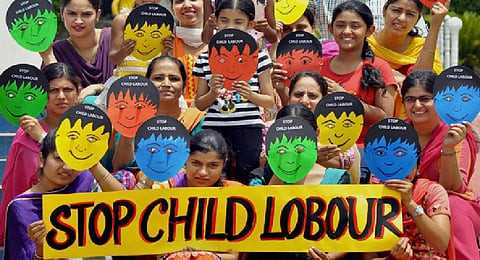Childhood, a lost labour of love
In the backdrop of World Day Against Child Labour which was observed last week, it’s pertinent to understand how this social evil persists in India, close to 75 years since independence. A March 2021 study titled Campaign Against Child Labour (CACL) – Tamil Nadu and Puducherry ‘Lost Gains – COVID-19’ revealed that the incidence of child labour among vulnerable communities had spiked by 280% due to the pandemic. A statement from the ILO and Unicef said COVID washed away progress made over two decades in the eradication of child labour.
The CACL report warned that the proportion of children hailing from vulnerable communities such as SC/ST that had been pushed into the workforce had spiked from 28.2% to 79.6% owing to the subsequent school closures. Almost 30.8% of the children were employed in the manufacturing sector while 26.4% of children were in services. Agriculture and home-based cottage industries comprise other areas of work. Over 94% of them were compelled into taking up jobs owing to financial burden at home, and pressure from families. But these numbers don’t even account for the children of migrant workers.
Last December, the Tamil Nadu government had planned on cracking down on bonded child labour, which is rampant in the delta districts of the State. Chief Minister MK Stalin had directly intervened and the Social Welfare Department had been pressed into conducting a detailed study on the issue. The problem was highlighted after four young boys employed as bonded labourers in a goat farm in Ramanathapuram, were rescued by a multitask department force in Thanjavur. The children, all under 10, were sold by their parents, who were farm workers for a sum of Rs 62,000 — an advance of the children’s salary.
While the children were handed over to the Child Welfare Committee, the CMO’s office informed that the administrations of Ramanathapuram, Thanjavur and other delta districts had been instructed to carry out raids at any such premises that could potentially harbour underage workers. Legislation wise, the Child Labour (Prohibition and Regulation) Act (CLPRA) of 1986, prohibits children upto the age of 14 from working in hazardous environments. The Centre had also identified 12 such hotspots that employ child labour, which includes the match and fireworks factories in Sivakasi.
The National Child Labour Project incepted in 1988, was the Union Labour and Employment Ministry’s flagship programme to rehabilitate child workers. In April this year, the programme, which was in force in 312 districts pan-India was halted abruptly and States were asked to rely upon the Samagra Shiksha Abhiyan to rescue and formally school child workers. To top it off, despite the National Policy for Children in 2013 defining children as those under the age of 18, the CLPR Amendment Act of 2016 legitimised adolescent labour (between 14-18 years) in all but hazardous occupations and processes.
Stakeholders have made several recommendations to the government to end the child labour problem in India. These include provision of minimum guarantee employment for all, social protection schemes to cover vulnerable families and stricter enforcement of labour laws. There were calls for the formation of a special policy to deal with the rescue and rehabilitation of child labourers, as well as the creation of residential schools, enhancing the budgetary allocations for child welfare schemes, and the passing of an anti-trafficking bill as most children pushed into labour have been trafficked. Movements like social activist Kailash Satyarthi’s Bachpan Bachao Andolan are also taking this dialogue forward in a big way.
Are you in Chennai? Then click here to get our newspaper at your doorstep!
Visit news.dtnext.in to explore our interactive epaper!
Download the DT Next app for more exciting features!
Click here for iOS
Click here for Android

